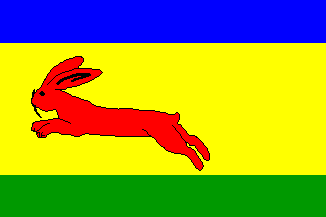 Shipmate Flagchart : http://www.flagchart.net
Shipmate Flagchart : http://www.flagchart.net
adopted 1963

Last modified: 2006-12-09 by jarig bakker
Keywords: gaasterland |
Links: FOTW homepage |
search |
disclaimer and copyright |
write us |
mirrors
 Shipmate Flagchart : http://www.flagchart.net
Shipmate Flagchart : http://www.flagchart.net
adopted 1963
![[Balk villageflag]](../images/n/nl-fr0bk.gif) by Jarig Bakker, 18 Aug 2003
by Jarig Bakker, 18 Aug 2003
Balk is a sleepy little village, and seat of Gaasterlân-Sleat
- the river Luts is one of my favorites, when, while sailing on the Frisian
lakes, the wind is too strong, you take a long loop through some canals
and the Luts, passing along "Kippenburg", a pub where you have to serve
yourself. But beware of the fierce flow of the Luts: it is said that in
the wild old days the water reached speeds of two meters per hour!
CoA: in gold a green wavy pale, over which a red shortened fess charged
with a golden six-pointed star; in gold with four green stemmed linden-leaves
2-2; in chief a "vlecke-kroon" (townlet-crown) of gold, joined red, with
three red lozengy stones and two green oval stones and on the bandeau a
wreath fastened of three leaves and two pearls.
Flag: a red hoist with a length of 1/4 flaglength with in the center
a yellow six-pointed star, the fly of three equally wide horizontal stripes
yellow - green - yellow with in the top towards the hoist a green stemmed
lindenleaf.
The green pale is the river Luts, which streams through this "vlecke",
formerly seat of the "grietenij" Gaasterland, over which the local red
bridge (is "balk), charged with the golden leading star, symbolizing the
"grietenijhuis" (former municipal council-house). the color red of the
red hare from the municipal arms before the golden corn-plant. The four
lindenleaves refer to the ancient linden-hedge along the quay of the Luts,
which was described in the poem of the Dutch auther Gorter "Mei" - May,
in which this townlet is described.
Balkh is one the the known Frisian "vlekken" (townlets), and is entitled
to a "vlekken-kroon".
Design: R.J. Broersma, member of the Fryske Rie foar Heraldyk
Sources: Genealogysk Jierboekje 1989.
Vexilla Nostra jg. 23 (nr. 159) pp. 107-108.
Jarig Bakker, 18 Aug 2003
I am sorry to nitpick, but it is a known fact that people in the ancient
times tended to exaggerate the specific characters of their villages. A
more conservative estimate of the Luts flow speed would be two meters per
day, except on those very windy days preventing sailing on the lakes.
[A Swiss citizen was recently sued by animal welfare activists in Bern
after having crushed a snail. His defendor answered the snail had been
continuously following her client for more than three hours.]
Festina lente.
Ivan Sache, 22 Aug 2003
![[Wyckel villageflag]](../images/n/nl-fr_wc.gif) by Jarig Bakker, 18 Aug 2003
by Jarig Bakker, 18 Aug 2003
Wyckel (municipality of Gaasterlân-Sleat), Fryslân,
CoA: in gold a red kestrel taking off, in top with two open roses of
the same, a green base charged with a horn of silver
Flag: two equally wide horizontal stripes yellow - green, with in the
topstripe a red kestrel towards the hoist, and in the lower stripe towards
the hoist a white horn.
The kestrel is in the Frisian language a "reade wikel" is canting for
the village-name. It occurs also on the arms of the van Wyckel family.
The roses are derived from the CoA of the van Wyckel family - they had
two "stinsen" here, hence the number of 2 roses. The horn in de base is
derived from the arms of Menno van Coehoorn, who was buried in Wyckel.
Van Coehoorn (1641-1704) was one of the greatest military experts of his
time, and was mainly responsible for the fortification of cities and castles
in the Netherlands.
The shield's colors (yellow and green) are from the Gaasterland CoA,
representing sandy soils and the meadows of the lower polder-areas.
The flag is derived from the CoA and is self-evident.
Design: R.J.Broersma, member of the Fryske Rie foar Heraldyk
Source: Genealogysk Jierboekje 1989.
Vexilla Nostra jrg. 23, 158, p. 108.
Jarig Bakker, 18 Aug 2003